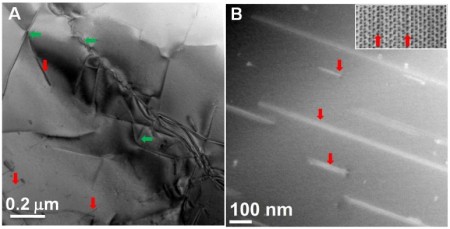Dec
1
New Thermoelectric Material Doped For High Productivity
December 1, 2015 | Leave a Comment
Northwestern University researchers are reporting that doping tin selenide with sodium boosts its performance as a thermoelectric material. The newly devised material produces a significantly greater amount of electricity than the undoped material, given the same amount of heat input. The researchers can confidently suggest the material pushes thermo electric technology closer to commercial usefulness.

Low magnification image of the typical regions of the hole doped SnSe in (A) the TEM model and (B) the STEM model. For more information click the study link below. For a larger image view click the image. Image Credit: Northwestern University.
During power production nearly two-thirds of energy input from fossil fuels is lost as waste heat. The power industry is looking at materials that can convert this heat to useful electricity, but a good thermoelectric material is hard to find. Increasing the efficiency of thermoelectric materials is essential if they are to be used commercially.
The Northwestern development could lead to new thermoelectric devices with potential applications in the automobile industry, glass and brick making factories, refineries, coal and gas fired power plants, and places where large combustion engines operate continuously (such as in large ships and tankers) – anywhere that heat is escaping out of the process stream.
Most semiconducting materials, such as silicon, have only one conduction band to work with for doping, but tin selenide is unusual and has multiple bands; the researchers took advantage of these bands. They showed they could use sodium to access these channels and send electrons quickly through the material, driving up the heat conversion efficiency.
Mercouri G. Kanatzidis, an inorganic chemist who led the multidisciplinary team explains, “The secret to our material is that multiband doping produces enhanced electrical properties. By doping multiple bands, we are able to multiply the positive effect. To increase the efficiency, we need the electrons to be as mobile as possible. Tin selenide provides us with a superhighway – it has at least four fast-moving lanes for hole carriers instead of one congested lane.”
Kanatzidis, a Charles E. and Emma H. Morrison Professor of Chemistry in the Weinberg College of Arts and Sciences, is a world leader in thermoelectric materials research and is a corresponding author of the paper.
To produce a voltage for example, a good thermoelectric material needs to maintain a hot side – where the waste heat is – while the other side remains cool. Thus a voltage can be harvested as power. Less than two years ago, Kanatzidis and his team, with postdoctoral fellow Lidong Zhao as protagonist, identified tin selenide as a surprisingly good thermoelectric material; it is a poor conductor of heat (much like wood) – a desirable property for a thermoelectric – while maintaining good electrical conductivity.
Kanatzidis’ colleague Christopher M. Wolverton, a computational theorist, calculated the electronic structure of tin selenide. He found the electrical properties could be improved by adding a doping material.
Wolverton, a senior author of the paper and professor of materials science and engineering in the McCormick School of Engineering and Applied Science explained, “Tin selenide is very unusual, not only because of its exceedingly low thermal conductivity, but also because it has many conduction lanes. Our calculations said if the material could be doped, its thermal power and electrical conductivity would increase. But we didn’t know what to use as a dopant.”
Sodium was the first dopant the researchers tried, and it produced the results they were looking for. “Chris’ computations opened our eyes to doping,” Kanatzidis said. He and Zhao successfully grew crystals of the new doped material.
The researchers also were pleased to see that adding sodium did not affect the already very low thermal conductivity of the material. It stayed low, so the heat stays on one side of the thermoelectric material. Electrons like to be in a low-energy state, so they move from the hot (high-energy) side to the cool side. The hot side becomes positive, and the cool side becomes negative, creating a voltage.
“Previously, there was no obvious path for finding improved thermoelectrics,” Wolverton said. “Now we have discovered a few useful knobs to turn as we develop new materials.
The efficiency of waste heat conversion in thermoelectrics is reflected by its “figure of merit,” called ZT. In April 2014, the researchers reported that tin selenide exhibits a ZT of 2.6 at around 650º C. That was the highest ZT to date – a world record. But the undoped material produced that record-high ZT only at that temperature. (There is a ZT for every temperature.)
The new doped material produces high ZTs across a broad temperature range, from room temperature to 500º C. Thus, the average ZT of the doped material is much higher, resulting in higher conversion efficiency.
“Now we have record-high ZTs across a broad range of temperatures,” Kanatzidis said. “The larger the temperature difference in a thermoelectric device, the greater the efficiency.”
This is the best possible news for the thermoelectric field. Activity from room temperature to 500º C is a massive breakthrough by itself. Its also likely that temperatures above that will be addressed soon. Two or more zones of activity isn’t going to be a barrier when hundreds of degrees Celsius is considered.
Congratulations are in order and well deserved. Maybe, finally one hopes, the technology has the first real step out of the lab at hand.

